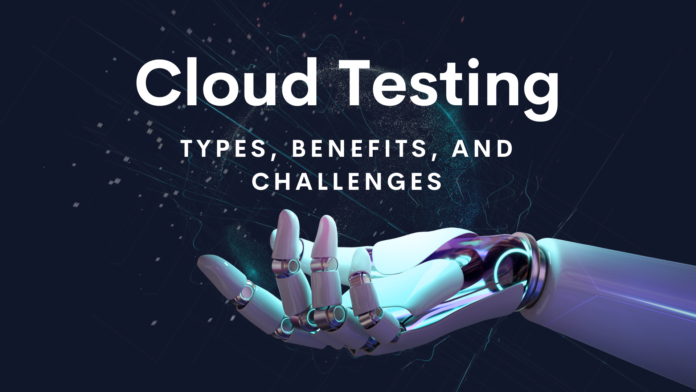Cloud testing is software testing where cloud computing services are used to test software applications. Cloud testing aims to test the program for functional and non-functional criteria with cloud computing, which offers faster availability with, scalability and flexibility to reduce time and expense for software testing.
In this blog, let us look at the types, benefits, and challenges of cloud testing.
Types of cloud testing
The subject of cloud testing falls under cloud operations. The various types of cloud testing are-
Functional Testing
In a cloud context, functional testing means evaluating all the system’s features and functionalities, including hardware and software. It is typically performed on a fully integrated software platform to ensure it meets the requirements.
System Testing
System testing ensures that a cloud-based application operates effectively under various system constraints.
Interoperability Testing
This testing determines whether a cloud-based application is adaptable and compatible enough to continue operating well despite a change in infrastructure.
Acceptance Testing
With acceptance testing, a specific cloud application is checked to ensure it meets user expectations by handing the app to the user.
Availability Testing
This testing is more of an administrator’s responsibility because they must ensure the cloud services are always accessible. Other cloud-based activities do not interfere with the functioning of the application in consideration.
Multi-tenancy Testing
Multi-tenancy tests check to see if a cloud-based application operates as it should despite tremendous traffic and several concurrent user requests.
Performance Testing
Performance testing assures that a cloud-based application can manage a specific volume of user requests. The cloud must also have some degree of elasticity to accommodate an increase in usage needs.
Security Testing
This testing guarantees that only people with the appropriate authority can access detailed data and that further layers protect the data stored in the cloud.
Disaster Recovery Testing
Data stored in the cloud may occasionally be lost due to unanticipated events. Disaster recovery testing examines how quickly and thoroughly this data can be retrieved.
Benefits of Cloud Testing
Mentioned below are the benefits of cloud testing.
Availability
Resources may be conveniently accessible anywhere and from any device with a network connection. As a result, the QA testing process is entirely free of any physical constraints like location. Also, thanks to the built-in collaboration features available, testing teams may work together in real-time to complete the cloud testing process.
Cost Effective
Since consumers only pay for what they use, cloud testing is more economical than traditional testing.
Scalability
Cloud testing has the capability to enable scaling up or down computer resources in accordance with the needs of the testing procedure.
Disaster Recovery is a lot Easier
The cloud makes disaster recovery operations more accessible than they are for conventional techniques. Cloud disaster recovery is a service businesses can use to recover essential data in an accident, such as a data breach. Remote file access is done in a secure virtual setting. This eliminates additional complications and makes disaster recovery a very straightforward approach.
Faster Testing Process
Compared to conventional testing methods, cloud testing is substantially faster. As a result, the marketing process can get started more quickly.
Challenges of Cloud Testing
The downsides of cloud testing exist. Delays and extra expenses may result from a lack of standards for integrating public cloud services with on-premises resources, worries about cloud security, unclear service-level agreements, and restricted configuration and bandwidth options.
Mentioned below are the challenges of cloud testing
Privacy of Data and Security
Security and privacy issues with cloud testing persist, just like with more widespread use of the cloud. Moreover, the consumer loses control over security and privacy concerns as the cloud environment is outsourced.
Applying the Multiple-Cloud Model
Multi-cloud models, which employ a variety of clouds—public, private, or hybrid, and occasionally some cloud service providers — provide challenges regarding synchronization, security, and other areas.
Lack of Resources and Expertise
The lack of resources or experience is one of the frequent cloud difficulties businesses and organizations face nowadays. Due to these circumstances, enterprises are struggling to keep up with the tools and knowledge.
Performance Issues
The performance of cloud-based apps is directly hampered by downtime. In any technology, downtime is a possibility. Some cloud suppliers have encountered difficulties in recent years. Customers find it challenging to rely on these services in such circumstances.
Development of Ecosystems
Specific server, network, and storage configuration problems may prevent cloud operations. Furthermore, it is difficult to recreate a user’s ecology since inconsistencies are sometimes impossible to get around. Additionally, the testing environment’s control constraints may not fully encompass the modules that need to be evaluated.
Bandwidth Issues
Due to shared resources on the provider’s end, bandwidth difficulties may occur. Handling high traffic with a restricted infrastructure may be difficult unless managed with more efficiency and maximal technical support.
Managing Costs
Cloud testing is a simple way for businesses to cut costs. However, it is frequently challenging to foresee and define quantities and pricing due to cloud services’ persistent demand and scalable nature.
Wrapping It Up
Creating applications is a developer’s job. But, the application needs to be ready for the real world. Hence, it must pass testing before being made available to end users.
However, establishing a lab with thousands of devices would be costly and counterproductive. As a result, cloud testing providers are equipped to enable device and browser compatibility testing.
Using TestGrid, users can perform end-to-end testing of their app/website on real devices/browsers hosted on the cloud or on-premise. TestGrid has made it super easy for testers to switch from manual to scriptless automation leading to a faster go to market.
















